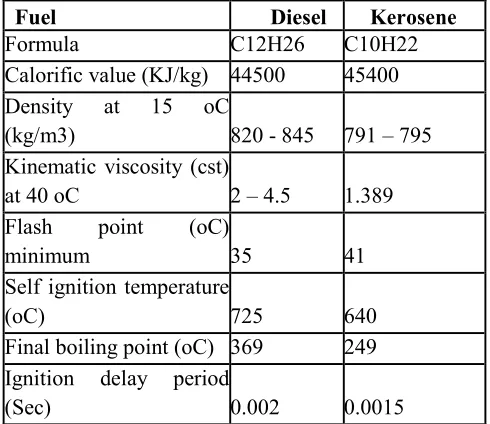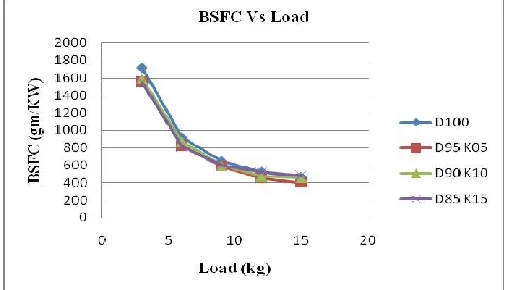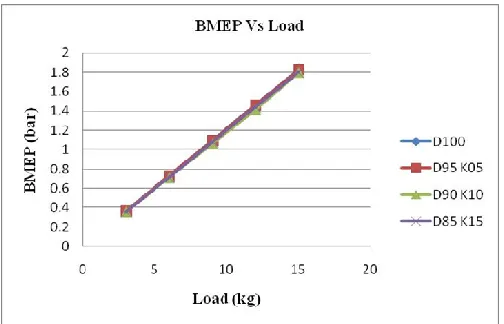© 2015 IJSRST | Volume 1 | Issue 5 | Print ISSN: 2395-6011 | Online ISSN: 2395-602X Themed Section: Science and Technology
Performance of Kerosene Oil Blend with Diesel Fuel on
Engine
Dr. R. Ramachandra
Principal & Professor, Department of Mechanical Engineering, SKD Engineering College, Gooty, Andhra Pradesh, India
ABSTRACT
The need of various transportation systems is increasing every day in such a fast developing world, and in the result of this, several vehicles and engine are increasing while conventional fuel like diesel and petrol are vanishing gradually with time. So it is need of the hour, we must have the alternative to above conventional fuels. The purpose of this experimental investigation is to study the effect of the blend kerosene oil blend together with conventional fuel on single cylinder diesel engine which is attached with eddy current dynamometer. An experimental analysis was made to check the diesel engine performance using various blends of kerosene with mineral diesel. Different blends of kerosene oil together with diesel in the ratio of 5%, 10% and 15% by volume and investigated under the different load conditions in a CI engine. The outcomes under various parameters were believed to be almost near to that of diesel fuel only. Different engine parameters such as brake power, brake specific fuel consumption, brake mean effective pressure, fuel consumption rate, exhaust gas temperature etc. have been determined and these were compared with diesel fuel.
Keywords : Brake Power, Diesel engine, Eddy current dynamometer, Exhaust gas temperature, Fuel consumption rate, Kerosene oil
I.
INTRODUCTION
Diesel engines are widely used in more or less every walk of life these days like transport, agriculture, industrial sectors etc. It is commonly used due to higher efficiency and easy operation. Fast diminishing fossil fuels has forced the researcher across the world to search alternative substitute of diesel or to reduce the consumption of fossil diesel [1]. A broad range of world researcher is working on biodiesel which can be made from vegetable oil either edible or non-edible both. Biodiesel has potential to take the position of fossil diesel [2]-[4]. The biodiesel fuel properties are very near to petrol diesel. Further biodiesel has slightly lower energy content than diesel but it can be utilized neat or its blend with diesel without appreciable engine modification. Serious efforts are made to use various types of fuels in existing CI engine to stretch the availability of fossil diesel [5]. High oil viscosity is seriously constrained to replace the diesel which causes longer ignition lag, incomplete combustion, poor fuel atomization and carbon deposits on the injector and
valve seats [6]. Apart from all these, the high injection pressure is required to inject the fuel in the engine cylinder. That's why various vegetable oil based modified fuel were explored like biomass, biogas, biodiesel etc. These resources of alternative energy are environmentally friendly but they require to be explored on different situations for their advantages, disadvantages and specific application [7], [8]. Bio-fuels may generate new agricultural products market and promote the development of the rural area for the reason that bio-fuels are derived from crops and almost two third of world population who depend on income from agriculture. Due to continuous exhaustion of world natural petroleum storages and the effect of environmental pollution, there is an immediate requirement of proper substitute fuels for use in diesel engines and this experiment is a little contribution in this direction [9].
ignition. Cetane number for diesel ranges from 40 to 52 while that of kerosene is around 49 [10]. This means that careful blending of diesel and kerosene could result in blended fuel with cetane numbers in the high end of the range [11], [12]. The cetane number of fuel indicates the auto ignition capability of the fuel and has a direct effect on delay in ignition. For shorter ignition delay, cetane number must be high and vice versa. The high cetane number of the fuel ensures early and smooth ignition and combustion of fuel. Since these properties are comparable to a blend of diesel and kerosene, this blend can be used in the engine without modifying it [13]-[15].
The major aim of this experimental work was to find out the effect of kerosene blend on diesel engine performance in detail and further this work may be expanded. The major criterion to be a suitable fuel for a diesel engine is the performance characteristics. This study was basically concerned with the assessment of specific fuel consumption rate, brake power and exhaust gas temperature of the blended fuel. Each performance characteristics are drawn and compared with normal diesel and explained on the basis of previous knowledge. This paper reports a cost effective investigation that blending of kerosene the comparatively cheaper fuel with a diesel.
II.
MATERIALS AND METHODS
A. FUEL USED
Almost every country of the world is using single grade diesel fuel for different purposes like CI engine fuel, residential heating, industrial furnaces etc. Kerosene is used in a domestic application like cooking, lighting etc. The kerosene and diesel fuel used in this experimental investigation were obtained from the local market which is easily available. Pure diesel which is denoted by D100 was taken from local fuel station and considered as baseline fuel. Three mixtures of diesel – kerosene (with 5%, 10% and 15% kerosene blending by volume) were named D95 K05, D90 K10 and D85 K15 respectively were used in this experimental investigation. The various properties of diesel and kerosene are discussed in table I.
TABLE I. Properties of Fuels
Fuel Diesel Kerosene
Formula C12H26 C10H22 Calorific value (KJ/kg) 44500 45400 Density at 15 oC
(kg/m3) 820 - 845 791 – 795 Kinematic viscosity (cst)
at 40 oC 2 – 4.5 1.389 Flash point (oC)
minimum 35 41 Self ignition temperature
(oC) 725 640 Final boiling point (oC) 369 249 Ignition delay period
(Sec) 0.002 0.0015
B. TEST ENGINE
The experiment was conducted in a single cylinder four stroke diesel engine attached with Eddy current dynamometer. The specifications of eddy current dynamometer and the diesel engine have been given in table II and table III respectively.
TABLE II. Specification of Eddy Current Dynamometer
TABLE III. Specification of Testing Engine Torque 4.7 Nm to 549 Nm RPM Up to 3500 RPM (Max) Coil voltages 0 – 80 V DC Standard Overload Up to 250% short time Class „F‟ insulation Standard
Item Specification
Engine Manufacturer Sonalika Fuel Type Diesel
Air induction Naturally aspirated, water cooled Number of cylinders 1
Maximum Power 5 HP @ 1500 rpm Bore diameter 95 mm
C. TEST PROCEDURE
Initially, the drained system starts refilling with pure diesel fuel before commencing test requires, making free from air bubbles that might be collected in the fuel supply system, the engine runs without load for 15 minutes for warm up and stability. Engine stability was determined by the exhaust temperature stability. Then the load 3 kg was applied with the help of the knob on the control panel and gradually increased. After 2 minutes for same load and rpm, the fuel line tap was then closed to detach the fuel tank from the diesel engine and to allow the fuel to be consumed from the pipette. Thus, the fuel consumption was determined by measuring the time consumed by the engine for a constant volume of fuel consumption, during the process all data were recorded. Every test was repeated to be more accurate and the mean value was considered and the final calculations were made.
III.
RESULTS AND DISCUSSIONS
Fig. 1 presents the plot between fuel consumption rate and the load at constant speed 1500 rpm. The rate of fuel consumption for diesel is higher in comparison to kerosene blend. All graphs are drawn for the common load vs fuel consumption rate and it is found different for various blends of kerosene by volume. The rate of fuel consumption is continuously increasing with increase in load from no load to maximum load for various blends of kerosene.
Figure 1. Fuel consumption rate as a function of load
Fig. 2 demonstrates the plot between brake specific fuel consumption vs load. As load increases brake fuel consumption decreases exponentially. The graph between brake specific fuel consumption and load in case of the diesel alone is almost equal to the diesel with
various blends of kerosene. Diesel alone fuel curve is observed slightly higher as compare to diesel with various kerosene blends.
Figure 2. Brake specific fuel consumption as a function of load
Fig. 3 shows the plot between Brake horse power and the load. The plot for diesel alone and with various blends of kerosene are found to be almost overlapped. Brake horse power increases with increment in the load for diesel alone as well as with various blends of kerosene.
Figure 3. Brake horse power as a function of load
Figure 4. Brake mean effective pressure as a function of load
Fig. 5 presents the plot between exhaust gas temperature and the load. Exhaust gas temperature increases with increase in the load and as we all know that for higher load more fuel is required and more fuel has to be burn to give more power. Hence higher exhaust gas temperature is observed. The plot for various blends of kerosene is observed slightly higher as compare with the plot for diesel alone.
Figure 5. Exhaust gas temperature as a function of load
Fig. 6 shows the plot of brake thermal efficiency and the load. As the graph shows that blends of kerosene are having efficiency slightly more than the efficiency for the case of diesel alone. Brake thermal efficiency increases with increase in the load.
Figure 6. Brake thermal efficiency as a function of load
IV.
CONCLUSION
The experimental analysis on four stroke single cylinder diesel engine attached with eddy current dynamometer with various blends of kerosene at rated rpm and at different load conditions on the lower side was performed and following results were concluded. Fuel consumption for various blends of kerosene is slightly lower than that of diesel alone consumption. The best performance is for D95 K05, means a blend of 5% kerosene by volume with diesel gives the best result at lower load. Brake power and brake mean effective pressure are found to be nearly same for both the diesel alone as well as with blends of kerosene at lower load. Exhaust gas temperature for any blend of kerosene is higher than that for diesel alone. It means the exhaust gas has taken away slightly more energy for blends of kerosene in comparison to that of diesel alone. Brake thermal efficiency is slightly higher for diesel with various blends of kerosene than that of diesel alone. Among all blends of kerosene, D95 K05 has best brake thermal efficiency at lower load.
V.
REFERENCES
[1]. R. Saravanan, P. Navaneetha Krishnan, R. Muralimanohar, “Experimental & Performance Analysis of Four Stroke CI Engine on Sapotaceae Biodiesel and its Blends” International Conference on Energy Efficient Technologies for Automobiles, Journal of Chemical and Pharmaceutical Sciences, special issue 6, pp. 312-315, 2015.
[2]. Sandeep Kumar Duran, Maninder Singh, Hardeep Singh, “Karanja and Rapeseed Biodiesel: An Experimental Investigation of Performance and Combustion Measurement for Diesel Engine”, International Journal of Scientific & Engineering Research, Vol. 6, Issue 1, pp. 295-299, 2015. [3]. R. K. Singh, Saswat Rath, “Performance Analysis
of Blends of Karanja Methyl Ester in a Compression Ignition Engine”, International Conference on Biomedical Engineering and Technology IPCBEE, Vol. 11, IACSIT Press, pp. 187-192, 2011.
Characteristics of Single Cylinder Diesel Engine Fuelled with Blends of Karanja Biodiesel and Diesel”, International Journal of Mechanical Engineering and Technology, Vol. 5, Issue 7, pp. 160-170, 2014.
[5]. Vishal Dekate, Dr. S. C. Kongre, “Experimental Investigation of CI Engine Fueled with Diesel and Kerosene Blend with Cotton Seed Oil – A Review, IJARIIE, Vol. 2, Issue 3, pp. 3881-3886, 2016.
[6]. V. Maniniyan, S. Sivaprakasam, “Performance, Combustion and Emission evaluation in DI Diesel Engine Using diesel and biodiesel”, Elixir International Journal Mechanical Engineering 52 (2012), pp. 11305-11308, 2012.
[7]. Suvendu Mohanty, Dr. Om Prakash, “Analysis of Exhaust Emission of Internal Combustion Engine using Biodiesel Blend”, International Journal of Emerging Technology and Advanced Engineering, Vol. 3, Issue 5, pp. 731-742, 2013.
[8]. Prem Kumar, M. P. Sharma, Gaurav Dwivedi, “Impact of Biodiesel on Combustion, Performance and Exhaust Emissions of Diesel Engines”, Journal of Integrated Science & Technology, 2(2), pp. 57-63, 2014.
[9]. Gaurav Sharma, Devendra Dandotiya, S. K. Agarwal, “Experimental Investigation of Performance Parameters of Single Cylinder IC Engine Using Mustard Oil”, International Journal of Modern Engineering Research, Vol. 3, Issue 2, pp. 832-838, 2013.
[10]. Dongmei Tong, Changwei Hu, Kanghua Jiang, “Cetane Number Prediction of Biodiesel from the Composition of the Fatty Acid Methyl Esters”, Journal of American Oil Chemists Society, Springer, Vol. 88, Issue 3, pp. 415-423, 2011. [11]. A. K. Azad, S. M. Ameer Uddin, M. M. Alam,
“Experimental study of DI diesel engine performance using biodiesel blends with kerosene”, International Journal of Energy and Environment, Vol. 4, Issue 2, pp. 265-278, 2013. [12]. Naseer Salman Kadhim, “Study the Effect of
Blending Kerosene with Diesel Fuel on the Performance and Emissions of Diesel Engine”, International Journal of Engineering Sciences & Research Technology, pp. 772-776, 2015.
[13]. Bilal A. Akash, “Combustion and Emission Investigation of Diesel Fuel and Kerosene
Blends”, Research Journal of Applied Sciences, Engineering and Technology”, 10(16), pp. 618-622, 2015.
[14]. Azeem Hafiz P. A., Naveen Sankar G. M., Murali Mohan R. K., Bilal Mohammed, “Experimental Analysis of the Performance Characteristics of Single Cylinder Diesel Engine Fueled using Kerosene-Diesel Blend”, International Journal of Research in Mechanical Engineering, Vol. 4, Issue 3, pp. 70-74, 2016.


